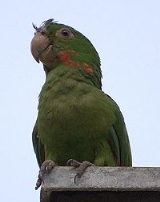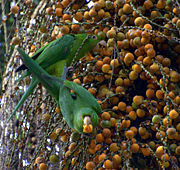
White-eyed Conure
Encyclopedia
The White-eyed Parakeet or White-eyed Conure (Aratinga leucophthalma) is a parrot
native to South America
.
in 1776, its specific epithet is derived from the Ancient Greek
leukos "white" and ophthalmos "eye".
 The White-eyed Parakeet measures 30–34 cm (11.8–13.4 in) in length and 37–40 cm (14.6–15.7 in) in wingspan, with a body mass of 100–218 g (3.5–7.7 oz). is an overall green bird with red on the shoulders and some random flecks of red on the head and neck. The underwing primary coverts
The White-eyed Parakeet measures 30–34 cm (11.8–13.4 in) in length and 37–40 cm (14.6–15.7 in) in wingspan, with a body mass of 100–218 g (3.5–7.7 oz). is an overall green bird with red on the shoulders and some random flecks of red on the head and neck. The underwing primary coverts
are red tipped yellow. A prominent white eye ring gives this species its name. In addition to the nominate, there are two very similar subspecies
, callogenys and nicefori, although the validity of the latter, based on a single specimen
, is questionable. Juveniles
have little or no red and yellow in their plumage
.
, Colombia
and the Guianas in the north across Brazil
to northern Argentina
and Uruguay
in forests, woodland, savanna and mangrove
s. Adapts readily to degraded and urban areas, provided there are sources of food and nesting places (under roofs and other cavities) and occurs in several cities.
They will usually start to go to nest in March or April, sometimes breeding throughout the year and having four to six clutches. The clutch size is usually four eggs. Chicks will sometimes start to talk by the time they are weaned and generally will talk by six months of age.
White-eyed Parakeets are sometimes confused with Finsch's Parakeets because both have the red and yellow epaulets under their wings. The White-eyed Parakeets lack the red triangle on the forehead as adults.
Parrot
Parrots, also known as psittacines , are birds of the roughly 372 species in 86 genera that make up the order Psittaciformes, found in most tropical and subtropical regions. The order is subdivided into three families: the Psittacidae , the Cacatuidae and the Strigopidae...
native to South America
South America
South America is a continent situated in the Western Hemisphere, mostly in the Southern Hemisphere, with a relatively small portion in the Northern Hemisphere. The continent is also considered a subcontinent of the Americas. It is bordered on the west by the Pacific Ocean and on the north and east...
.
Taxonomy
First described by German zoologist Philipp Ludwig Statius MüllerPhilipp Ludwig Statius Müller
Philipp Ludwig Statius Muller was a German zoologist.Statius Muller was born in Esens, and was Professor of Natural Science at Erlangen. Between 1773 and 1776, he published a German translation of Linnaeus's Natursystem...
in 1776, its specific epithet is derived from the Ancient Greek
Ancient Greek
Ancient Greek is the stage of the Greek language in the periods spanning the times c. 9th–6th centuries BC, , c. 5th–4th centuries BC , and the c. 3rd century BC – 6th century AD of ancient Greece and the ancient world; being predated in the 2nd millennium BC by Mycenaean Greek...
leukos "white" and ophthalmos "eye".
Description

Covert (feather)
A covert feather on a bird is one of a set of feathers, called coverts, which as the name implies, cover other feathers. The coverts help to smooth airflow over the wings and tail.- Wing-coverts :...
are red tipped yellow. A prominent white eye ring gives this species its name. In addition to the nominate, there are two very similar subspecies
Subspecies
Subspecies in biological classification, is either a taxonomic rank subordinate to species, ora taxonomic unit in that rank . A subspecies cannot be recognized in isolation: a species will either be recognized as having no subspecies at all or two or more, never just one...
, callogenys and nicefori, although the validity of the latter, based on a single specimen
Specimen
A specimen is a portion/quantity of material for use in testing, examination, or study.BiologyA laboratory specimen is an individual animal, part of an animal, a plant, part of a plant, or a microorganism, used as a representative to study the properties of the whole population of that species or...
, is questionable. Juveniles
Juvenile (organism)
A juvenile is an individual organism that has not yet reached its adult form, sexual maturity or size. Juveniles sometimes look very different from the adult form, particularly in terms of their colour...
have little or no red and yellow in their plumage
Plumage
Plumage refers both to the layer of feathers that cover a bird and the pattern, colour, and arrangement of those feathers. The pattern and colours of plumage vary between species and subspecies and can also vary between different age classes, sexes, and season. Within species there can also be a...
.
Distribution and habitat
White-eyed Parakeets are found over much of northern South America, from eastern VenezuelaVenezuela
Venezuela , officially called the Bolivarian Republic of Venezuela , is a tropical country on the northern coast of South America. It borders Colombia to the west, Guyana to the east, and Brazil to the south...
, Colombia
Colombia
Colombia, officially the Republic of Colombia , is a unitary constitutional republic comprising thirty-two departments. The country is located in northwestern South America, bordered to the east by Venezuela and Brazil; to the south by Ecuador and Peru; to the north by the Caribbean Sea; to the...
and the Guianas in the north across Brazil
Brazil
Brazil , officially the Federative Republic of Brazil , is the largest country in South America. It is the world's fifth largest country, both by geographical area and by population with over 192 million people...
to northern Argentina
Argentina
Argentina , officially the Argentine Republic , is the second largest country in South America by land area, after Brazil. It is constituted as a federation of 23 provinces and an autonomous city, Buenos Aires...
and Uruguay
Uruguay
Uruguay ,officially the Oriental Republic of Uruguay,sometimes the Eastern Republic of Uruguay; ) is a country in the southeastern part of South America. It is home to some 3.5 million people, of whom 1.8 million live in the capital Montevideo and its metropolitan area...
in forests, woodland, savanna and mangrove
Mangrove
Mangroves are various kinds of trees up to medium height and shrubs that grow in saline coastal sediment habitats in the tropics and subtropics – mainly between latitudes N and S...
s. Adapts readily to degraded and urban areas, provided there are sources of food and nesting places (under roofs and other cavities) and occurs in several cities.
Aviculture
Though not as popular as some of the more colorful parakeets, the White-eyed Parakeet can become a sweet, loving and talkative pet. They are seldom destructive and are generally not screamers, often choosing to mimic speech instead. Although many breeders ignore this species, those that do breed them appreciate their good parenting skills. Breeding requirements for White-eyed Parakeets are much the same as for other parakeet species.They will usually start to go to nest in March or April, sometimes breeding throughout the year and having four to six clutches. The clutch size is usually four eggs. Chicks will sometimes start to talk by the time they are weaned and generally will talk by six months of age.
White-eyed Parakeets are sometimes confused with Finsch's Parakeets because both have the red and yellow epaulets under their wings. The White-eyed Parakeets lack the red triangle on the forehead as adults.
External links
- "White-eyed Parakeet" videos on the Internet Bird Collection
- Stamps (for French GuianaFrench GuianaFrench Guiana is an overseas region of France, consisting of a single overseas department located on the northern Atlantic coast of South America. It has borders with two nations, Brazil to the east and south, and Suriname to the west...
, ParaguayParaguayParaguay , officially the Republic of Paraguay , is a landlocked country in South America. It is bordered by Argentina to the south and southwest, Brazil to the east and northeast, and Bolivia to the northwest. Paraguay lies on both banks of the Paraguay River, which runs through the center of the...
) with ~RangeMap - "White-eyed Parakeet" photo gallery VIREO

